Sorting data helps keep your Excel tables organized, readable, and ready for analysis. While manual sorting works for small datasets, VBA allows you to automate the process, saving time and reducing errors, especially when working with large or dynamic tables.
In this article, you will learn four practical VBA methods to sort an Excel Table. We will cover how to sort by a single column value, sort by multiple columns, sort by cell color, and sort by icon, each method giving you greater control over how your table is organized.
Sort an Excel Table by the Price Column Using VBA
➤ Format your dataset as an Excel Table and name it ProductTable (via Table Design >> Table Name).
➤ Press Alt + F11 , go to Insert >> Module, and paste the code below:
Sub SortTableByPrice()
Dim ws As Worksheet
Dim tbl As ListObject
Set ws = ThisWorkbook.Sheets("Sheet1") ' Target worksheet
Set tbl = ws.ListObjects("ProductTable") ' Reference the Excel Table
' Sort the Price column in ascending order
With tbl.Sort
.SortFields.Clear
.SortFields.Add Key:=tbl.ListColumns("Price").Range, _
SortOn:=xlSortOnValues, Order:=xlAscending, DataOption:=xlSortNormal
.Header = xlYes
.Apply
End With
MsgBox "Table sorted by Price (Low to High).", vbInformation
End Sub
➤ Press Alt + F8 , select SortTableByPrice, and click Run.
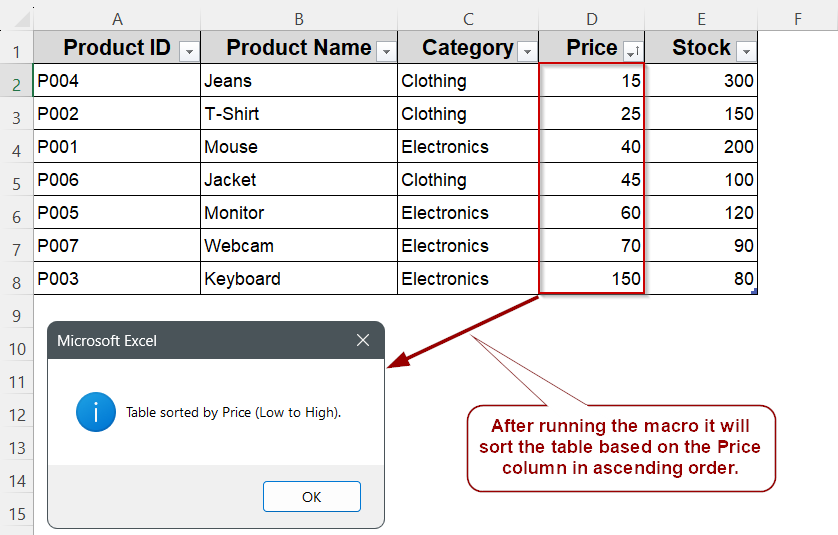
Embed VBA to Sort Table by Value in Excel
Sorting a table by a specific column (like Price) is one of the most common ways to organize data. Instead of doing this manually, you can use VBA to sort your Excel ListObject (table) with one line of code.
In this example, we will sort the Product Table by the Price column in ascending order using VBA. The macro targets the table directly, making it robust even if the number of rows changes.
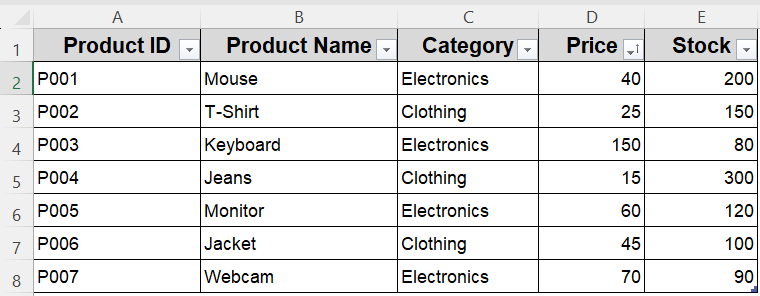
Steps:
➤ Press Alt + F11 to open the VBA editor
➤ Go to Insert >> Module
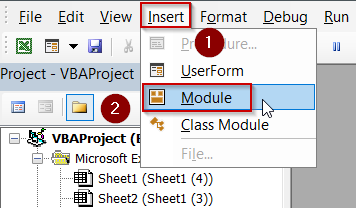
➤ Paste the following code:
Sub SortTableByPrice()
Dim ws As Worksheet
Dim tbl As ListObject
Set ws = ThisWorkbook.Sheets("Sheet1") ' Adjust if needed
Set tbl = ws.ListObjects("ProductTable") ' Use the actual name of your table
' Apply sort on the Price column using the header name
With tbl.Sort
.SortFields.Clear
.SortFields.Add Key:=tbl.ListColumns("Price").Range, _
SortOn:=xlSortOnValues, Order:=xlAscending, DataOption:=xlSortNormal
.Header = xlYes
.Apply
End With
MsgBox "Table sorted by Price (Low to High).", vbInformation
End Sub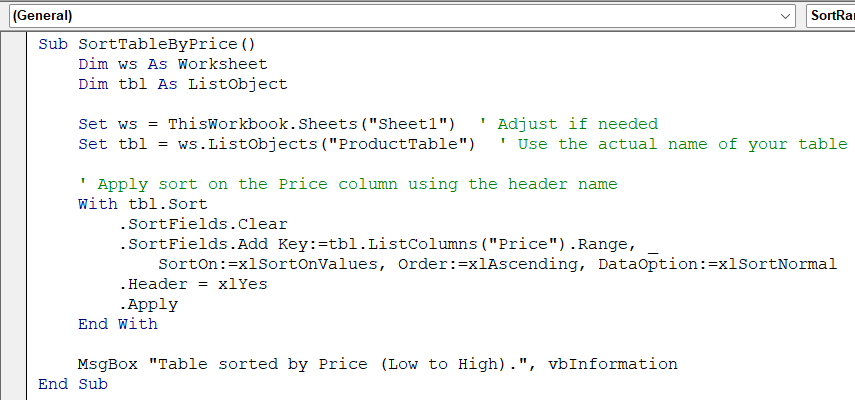
➧ tbl.ListColumns("Price").Range sorts based on the Price column by header name
➧ No need for lastRow or manual range definition, the table handles dynamic sizing
➧ A message box confirms when the sorting is done
➤ Go back to Excel
➤ Press Alt + F8 , select SortTableByPrice, and click Run
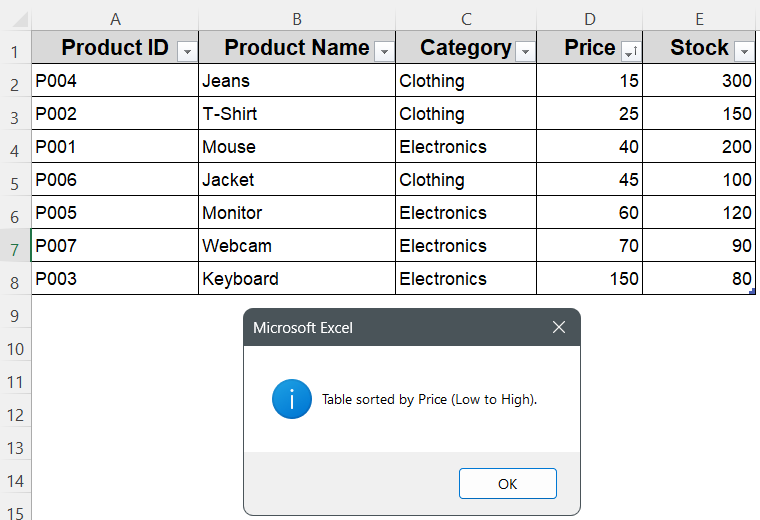
➤ Your table will be sorted by Price, from lowest to highest.
Insert VBA Macro to Sort Table for Multiple Columns
When analyzing datasets like product inventories, sorting by just one column isn’t always enough. For example, you might want to first sort by Category alphabetically, and then by Price within each category. This dual-level sort ensures better organization and readability.
In this method, we’ll sort the Product Table by Category (ascending) and then Price (descending).
Steps:
➤ Press Alt + F11 , choose Insert >> Module, and paste this code:
Sub SortTableByCategoryAndPrice()
Dim ws As Worksheet
Dim tbl As ListObject
Set ws = ThisWorkbook.Sheets("Sheet1") ' Change sheet name if needed
Set tbl = ws.ListObjects("ProductTable") ' Replace with your actual table name
' Apply two-level sort: Category then Price
With tbl.Sort
.SortFields.Clear
.SortFields.Add Key:=tbl.ListColumns("Category").Range, _
SortOn:=xlSortOnValues, Order:=xlAscending, DataOption:=xlSortNormal
.SortFields.Add Key:=tbl.ListColumns("Price").Range, _
SortOn:=xlSortOnValues, Order:=xlDescending, DataOption:=xlSortNormal
.Header = xlYes
.Apply
End With
MsgBox "Sorted by Category (A-Z), then Price (High to Low).", vbInformation
End Sub 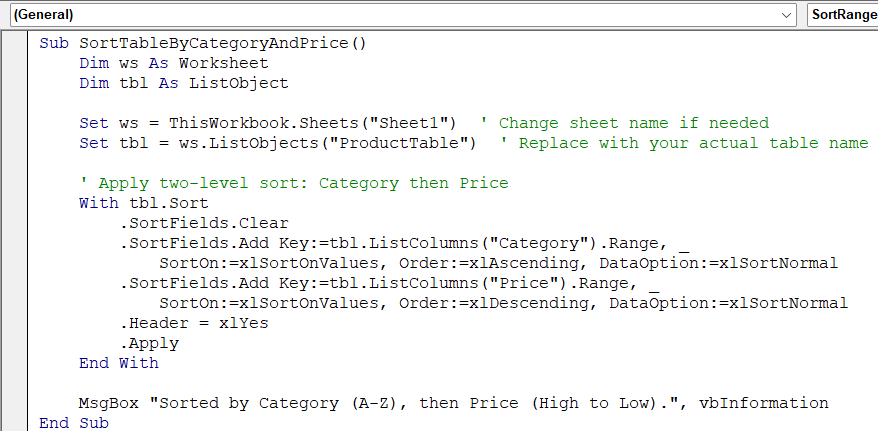
➧ tbl.ListColumns("Price").Range adds a second sort by Price, highest to lowest
➧ .SortFields.Clear ensures any prior sort rules are removed before applying new ones
➧ The sort respects the table headers and applies cleanly to the structured data
➤ Return to Excel, press Alt + F8 , select SortTableByCategoryAndPrice, and click Run
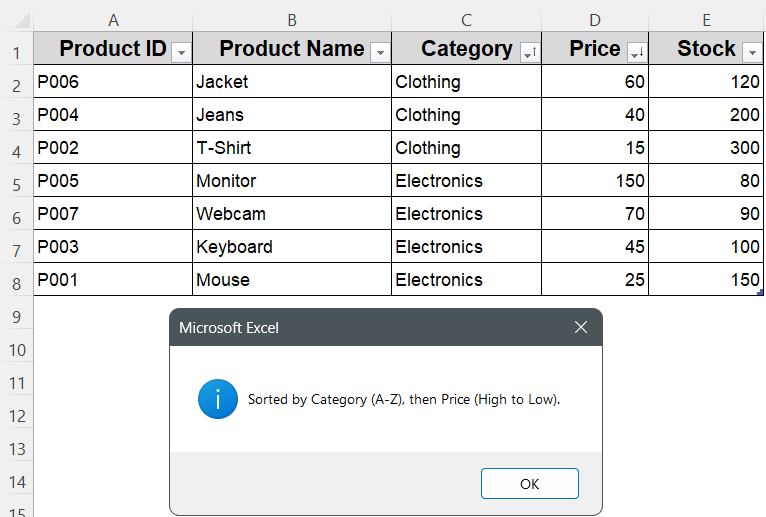
➤ Your table will now be sorted by Category, and within each Category by Price (descending)
Implement a Macro to Sort a Table by Cell Color in Excel
Sorting by cell color is useful when you’ve visually flagged rows, such as marking urgent items in red or completed ones in green. This macro sorts your Excel Table based on the fill color in the Status column.
In this method, we’ll sort the Product Table by the color in column E (Status). The macro places all rows with a specific fill color (e.g., red) at the top of the table.
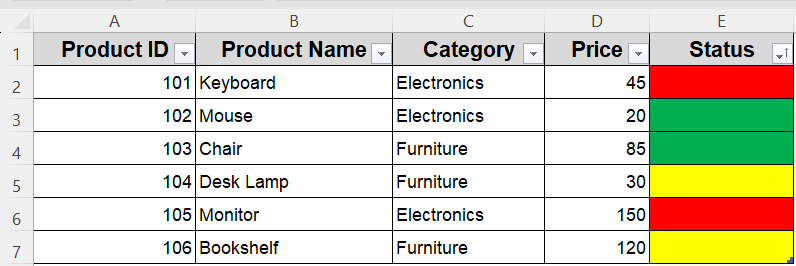
Steps:
➤ Press Alt + F11 , go to Insert >> Module, and paste the following code:
Sub SortTableByStatusColor()
Dim ws As Worksheet
Dim tbl As ListObject
Dim colorToSort As Long
Dim sortCol As Range
Set ws = ThisWorkbook.Sheets("Sheet1") ' Change if needed
Set tbl = ws.ListObjects("ProductTable") ' Replace with your table name
' Define the color to sort (e.g., red)
colorToSort = RGB(255, 0, 0)
' Define the Status column (assumed named "Status")
Set sortCol = tbl.ListColumns("Status").DataBodyRange
' Perform the sort by cell color in the Status column
With tbl.Sort
.SortFields.Clear
.SortFields.Add( _
Key:=sortCol, _
SortOn:=xlSortOnCellColor, _
Order:=xlAscending, _
DataOption:=xlSortNormal _
).SortOnValue.Color = colorToSort
.Header = xlYes
.Apply
End With
MsgBox "Rows with red fill in Status column sorted to top.", vbInformation
End Sub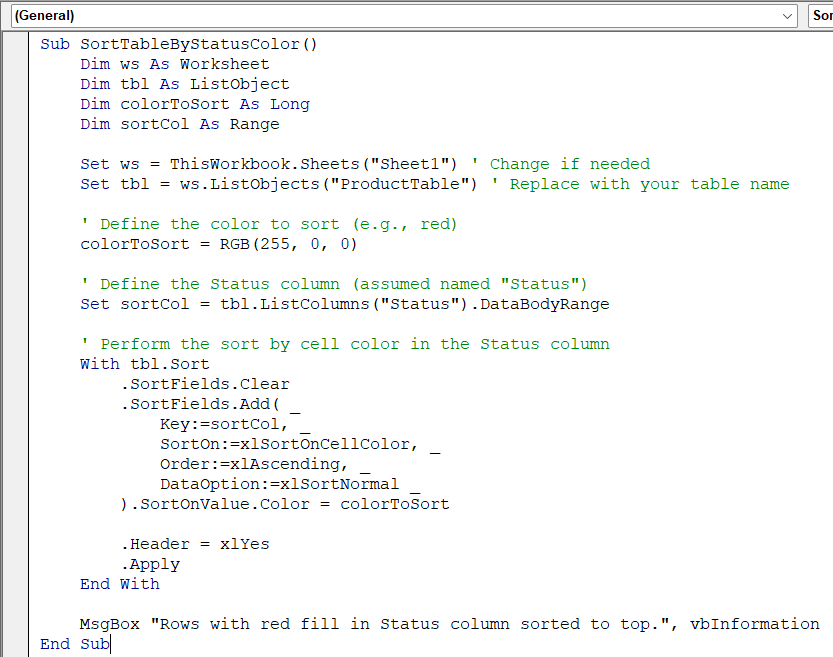
➧ tbl.ListColumns("Status").DataBodyRange targets the Status column of the table
➧ The macro uses .SortOn:=xlSortOnCellColor to sort by cell background color
➧ The sort applies to the entire table, keeping rows intact
➧ A message box confirms once sorting is complete
➤ Return to Excel, press Alt + F8 , select SortTableByStatusColor, and click Run.
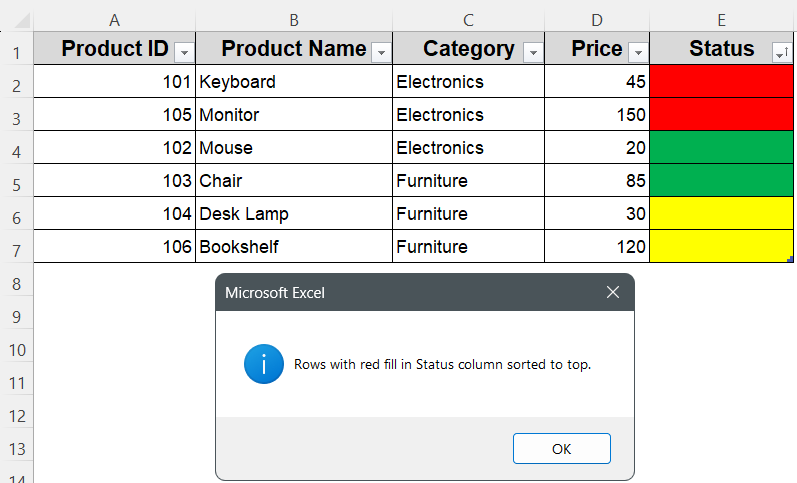
➤ The table is now sorted to place all red-filled rows in the Status column at the top.
Frequently Asked Questions
Can VBA sort an Excel table automatically when data changes?
Yes! You can use the Table.Update or event-triggered macros (like Worksheet_Change) to reapply sort order whenever data updates, ensuring your table remains correctly ordered.
How do I reference a table column in VBA for sorting?
In VBA, use ListObject.ListColumns(“ColumnName”).DataBodyRange to identify the column. Then apply sorting methods like .SortFields.Add or .SortFields.AddIconSort for value or icon-based sorting.
Does sorting a table in VBA affect formulas or formatting?
No. VBA’s table sorting moves rows entirely, preserving formula references, cell formatting, and conditional rules. You’re only changing row order, not altering cell content or structure.
Can VBA sort by more than one column in a table?
Absolutely. Use .SortFields.Add multiple times on different columns, set their order, then .Apply. VBA supports multilevel sorts, such as sorting by Category then by Value.
Wrapping Up
Sorting tables with Excel VBA gives you powerful control over how your data is organized. Whether you’re sorting by values, multiple columns, colors, or icons, VBA lets you automate the process for speed and consistency. With just a few lines of code, you can handle dynamic datasets and keep everything neatly ordered. Try out the methods in this article to personalize your sorting tasks to your exact needs.


